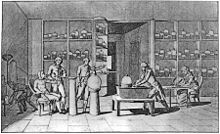18th and 19th century: Lind, Lavoisier and modern science
Sometimes forgotten during his life, James Lind, a physician in the British navy, performed the first scientific nutrition experiment in 1747. Lind discovered that lime juice saved sailors that had been at sea for years from scurvy, a deadly and painful bleeding disorder. Between 1500 and 1800, an estimated two million sailors had died of scurvy.[172] The discovery was ignored[by whom?] for forty years, but after about 1850, British sailors became known as "limeys".[173] The essential vitamin C within citrus fruits would not be identified by scientists until 1932.[172]
Around 1770, Antoine Lavoisier discovered the details of metabolism, demonstrating that the oxidation of food is the source of body heat. Called the most fundamental chemical discovery of the 18th century,[175] Lavoisier discovered the principle of conservation of mass. His ideas made the phlogiston theory of combustion obsolete.[176]
In 1790, George Fordyce recognized calcium as necessary for the survival of fowl. In the early 19th century, the elements carbon, nitrogen, hydrogen, and oxygen were recognized[by whom?] as the primary components of food, and methods to measure their proportions were developed.[177]
You received this message because you are subscribed to the Google Groups "2Top-manitotasy-Mirror1" group.
To unsubscribe from this group and stop receiving emails from it, send an email to 2top-manitotasy-mirror1+unsubscribe@googlegroups.com.
To view this discussion on the web visit https://groups.google.com/d/msgid/2top-manitotasy-mirror1/CACHR9V0JLWLZeUOY1Z0OO%2B_%2BS0-sS3Ji%3DT-f-3ywOgnQ76ASxA%40mail.gmail.com.


No comments:
Post a Comment